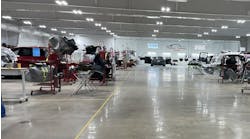Detroit may still be synonymous with the world’s automotive industry, yet Ontario has overtaken the Motor City in motor vehicle production. And while Motown’s fabled assembly lines are increasingly threatened with becoming rusted relics, the region surrounding the city is home to a robust family business-based aftermarket driven by a strong force of independent WDs, jobbers and retailers.
Several local independents have united to form the AP Co-op, which provides better buying power to keep them in the fight against other competitors. Some of these AP members have conflicting territories, yet they remain in close communication with one another.
Another factor in the market’s favor is close family ties over multiple generations, including a younger set that has at least a few future local industry leaders poised to carry on the tradition.
The acquisitions arena is the vehicle of choice for most expansion-minded aftermarket entrepreneurs, as the area is essentially fully developed except for outlying communities experiencing newer subdivisions and related retail. Much of this activity, however, involves people migrating from Detroit’s inner-ring suburbs to homes in the country rather than new residents moving in.
AutoZone and Advance Auto Parts are in place throughout Wayne, Oakland, Macomb and Saint Clair counties, especially in the developing suburbs.
Aftermarket insiders contend that the dominant Detroit discount retailer remains the venerable Murray’s Discount Auto Parts, which has been steadily expanding throughout the Midwest since 1972. Murray’s reportedly accounts for half of this region’s retail auto parts sales.
Numerous aftermarket participants display an open affinity for their counterparts in the industry — taking a we’re-all-in-the-same-boat approach — except for maybe “the corporate stores” belonging to AutoZone and Advance. NAPA and CARQUEST are in play, too, although the independents continue to display a prominent presence.
In the past, Detroit gleefully greeted the teeming masses streaming into town to man a seemingly endless supply of good-paying factory jobs serving the auto industry. Those days are gone. But as the remaining residents move from the urban environs to the wider spaces of suburbia, they’re certainly still driving cars in need of parts and repairs.
To download the full article and statistics on Detroit,





